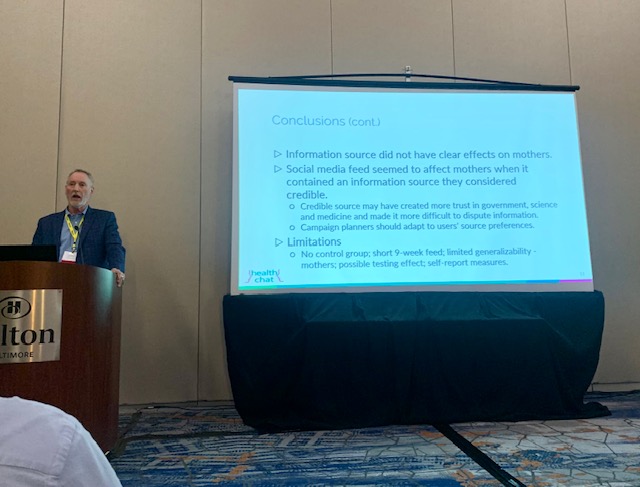
COVID-19 Social Media Feed for Mothers and Teen Daughters
Social media is a key channel for information on COVID-19 from government agencies, near-peers, and news media. The Health Chat team developed a social media feed that varied type of information source in posts on social distancing, COVID-19 vaccines, digital and media literacy, and family communication. Dr. David Buller from Klein Buendel presented findings from the COVID-19 social media feed at the 43rd Annual Meeting & Scientific Sessions of the Society of Behavioral Medicine in Baltimore, MD, April 6-9 2022.
A total of 303 mothers with adolescent daughters from a previous study testing a social media campaign on indoor tanning were recruited in January 2021 and enrolled in a randomized single-factor design (government agencies v. near-peer parents v. news media) of a 9-week Facebook feed with four assessments (baseline, 3-week, 6-week, and 9-week follow-ups). The feed contained five posts per week based on social cognitive theory, transportation theory, and diffusion of innovation theory. Mothers reported on social distancing and vaccine intentions for self and daughters.
Using intention-to-treat analyses, mothers’ reports of social distancing by self and daughter declined over the 9-weeks. Daughters’ social distancing declined faster in the near-peer condition but less quickly in the government condition. Vaccine intentions increased over the nine weeks in all experimental condition. Baseline intentions seemed to moderate effect of condition on change in intentions. Mothers with initially high vaccine intentions (relative to moderate intentions) assigned to the government condition reported a less steep increase in intentions over time and had slightly lower intentions to vaccinate at the end of the study. Baseline credibility of the assigned information source predicted increased vaccine intentions. However, in the near-peer condition, mothers who assigned them lower as opposed to higher credibility showed increased vaccine intentions.
Theory-based posts emphasizing information from government agencies may have provided credible counterarguments against local jurisdictions relaxing pandemic restrictions that slowed declines in daughters’ social distancing. The near-peer sources may have been influential with mothers who did not expect them to convey the credible arguments supporting vaccines which they did in the experimental feed, consistent with violations of expectations theory in persuasive communication.
This research is funded by a grant and supplement from the National Cancer Institute (CA192652; Dr. David Buller and Dr. Sherry Pagoto, Multiple Principal Investigators). Authors on this presentation include Dr. Sherry Pagoto and Joseph Divito from the University of Connecticut; Dr. Kim Henry from Colorado State University; and Dr. David Buller, Dr. Barbara Walkosz, Dr. Gill Woodall, Julia Berteletti, and Alishia Kinsey from Klein Buendel.
